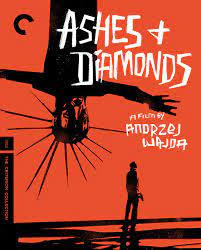Paul Coates at The Current:
 Andrzej Wajda’s Ashes and Diamonds (1958) has rightly been lauded as one of the finest of postwar East-Central European films, and the most vital work of the Polish School, the group of filmmakers who, starting in the midfifties, cast startlingly truthful images of the recent war and its aftermath, putting Polish cinema on the world map. It is salutary, however, to remember how much controversy has dogged the film within Poland itself, and that it is more than a matter of regime-led misgivings about a work with potentially subversive accents. It stems from the film’s pursuit of conflicting goals: to deal with the Polish Home Army’s resistance against the incoming, Soviet-backed Communist regime and yet satisfy both the Polish populace who held that army dear and a Communist Party that wielded powers of censorship, even though it had renounced a Stalinist rigor of repression. Criticize the Home Army too strongly and the audience will turn on you; offend the regime and your film might be amputated or aborted. (Wajda himself reported efforts to remove the protagonist’s death scene going right down to the wire of the first screening.)
Andrzej Wajda’s Ashes and Diamonds (1958) has rightly been lauded as one of the finest of postwar East-Central European films, and the most vital work of the Polish School, the group of filmmakers who, starting in the midfifties, cast startlingly truthful images of the recent war and its aftermath, putting Polish cinema on the world map. It is salutary, however, to remember how much controversy has dogged the film within Poland itself, and that it is more than a matter of regime-led misgivings about a work with potentially subversive accents. It stems from the film’s pursuit of conflicting goals: to deal with the Polish Home Army’s resistance against the incoming, Soviet-backed Communist regime and yet satisfy both the Polish populace who held that army dear and a Communist Party that wielded powers of censorship, even though it had renounced a Stalinist rigor of repression. Criticize the Home Army too strongly and the audience will turn on you; offend the regime and your film might be amputated or aborted. (Wajda himself reported efforts to remove the protagonist’s death scene going right down to the wire of the first screening.)
more here.
